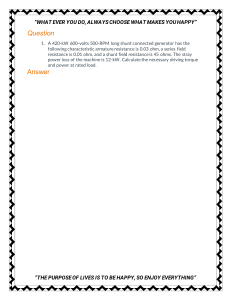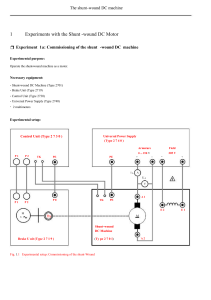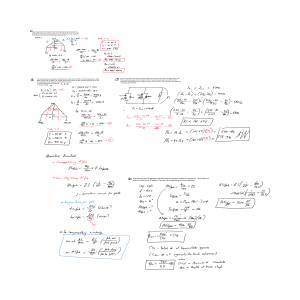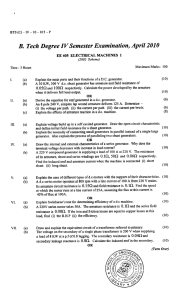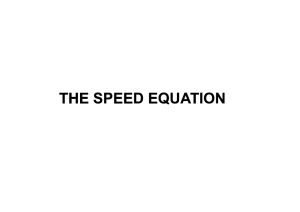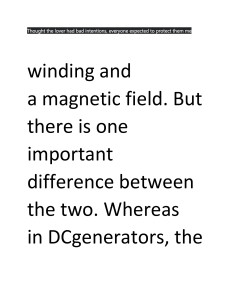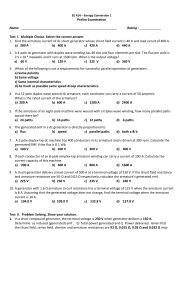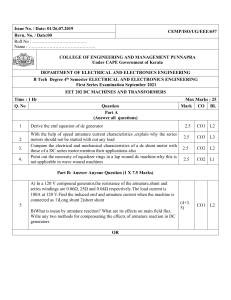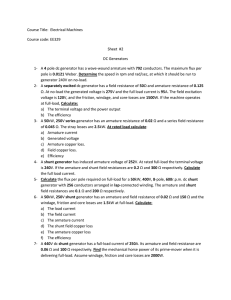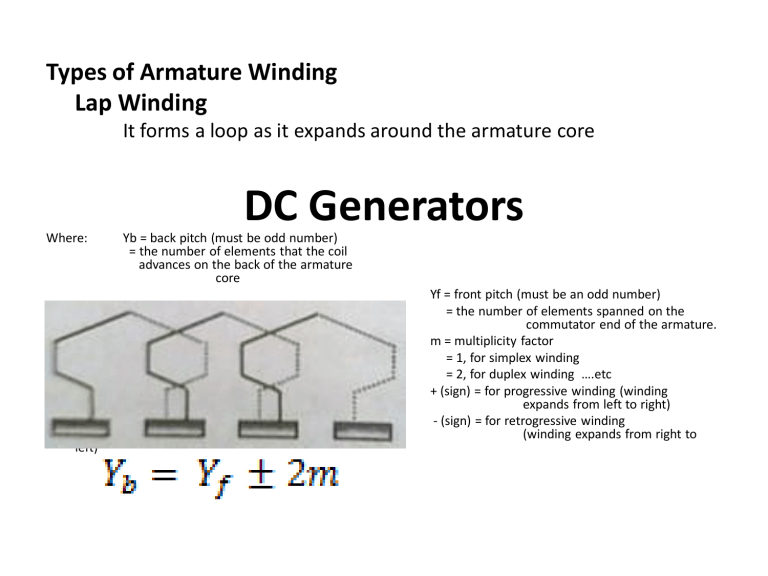
Types of Armature Winding Lap Winding It forms a loop as it expands around the armature core Where: left) DC Generators Yb = back pitch (must be odd number) = the number of elements that the coil advances on the back of the armature core Yf = front pitch (must be an odd number) = the number of elements spanned on the commutator end of the armature. m = multiplicity factor = 1, for simplex winding = 2, for duplex winding ….etc + (sign) = for progressive winding (winding expands from left to right) - (sign) = for retrogressive winding (winding expands from right to Wave Winding It forms a wave as it expands around the armature core. Where: Y = average pitch (must be integer) Z = total number of winding an elements on the surface of the armature core P = number of poles Minimum Number of Elements or Conductors per Slot (if not specified) Types of Winding Elements per Slot Simplex 2 Duplex 4 Triplex 6 Quadruflex 8 Total Number of Elements or Conductors Z = (elements/slot)(total number of slots) Number of Brushes (if not specified) Nlap = P Nwave = 2 Number of Commutator segments Nc = Z/2 Number of Armature Current Paths (a): alap = mP alap = 2m Coil Pitch (Ys) Generated EMF Equation of a DC Generator Where: E = generated emf(volt) P = number of poles N = speed of armature core rotation (rpm) Z = total number of elements or conductors Φ = flux per pole (weber) a = number of armature current paths k = proportionality constant Note: 1 weber = 1 x 108 maxwells lines of flux Types of Generator According to Excitation Separately Excited The field windings of the generator is excited from a separate source usually a battery Self – Excited The field windings of the generator is supplied or excited from its own generated emf. Shunt Generator The armature coils and the shunt field coils are connected in parallel Series Generator The armature coils and the series field coils are connected in series Example 1. A four-pole dc generator with lap winding has 48 slots and 4 elements per slot. How many coils does it have? Example 2. If the armature of an eight-pole machine were wound with a simplex wave winding, how many parallel paths would there be? Example 3. The armature of a four-pole shunt generator is lap wound and generates 216 volts when running at 600 rpm. The armature has 144 slots, with six conductors per slot. If this armature is rewound, wave connected, find the emf generated at the same speed and flux per pole. Example 4. A two-pole DC generator has an armature containing a total of 40 conductors connected in two parallel paths. The flux per pole is 6.48 x 108 lines and the speed of the prime mover is 30 rpm. The resistance of each conductor is 0.01 ohm and the current carrying capacity of each conductor is 10 A. Calculate the terminal voltage of the generator. Example 5. A four-pole Dc generator has an armature winding containing a total of 648 conductors connected in two parallel paths. If the flux per pole is 0.321 x 106 maxwells and the speed of rotation of the armature is 1 800 rpm. Calculate the ampacity required in each armature conductor if the power developed by the armature is 5 kW. Example 6. A 4-pole DC generator with duplex lap winding has 48 slots and four elements per slot. The flux per pole is 2.5 x 106 maxwells and it runs at 1 500 rpm. What is the output voltage? Example 7. The armature of a 4-pole, 128 slots shunt generator is lap wound with four conductors per slot. The flux per pole is 50 mWb. The armature and shunt field resistances are 0.04 ohm and 50 ohms respectively. Determine the speed of the machine when supplying 400 A at a terminal voltage of 250 V. Example 8. A four-pole shunt connected generator has a lap connected armature with 728 conductors. The flux per pole is 25 mWb. If the generator supplies two hundred fifty 110 V, 75 W incandescent lamp. The field and armature resistances are 110 ohms and 0.025 ohm respectively. Determine the speed in rpm of the generator. Example 9. A speed-indicating device consists of a 2-pole permanent magnet DC generator with a 2000-ohms DC voltmeter connected across its terminals. The generator has an armature with 1200 conductors having two parallel paths and a total resistance of 1000 ohms between brushes. The air-gap flux is 40 000 liners per pole. If the voltmeter reads 10 V, at what speed will this reading indicates? Example 10. A shunt generator supplies a load of 5,500 W at 110 V through a pair of feeder conductors having a resistance of 0.02 ohm each. The armature, shunt field resistances are 0.15 ohm and 50 ohms respectively. Find the emf generated. Example 11. The no-load voltage of a 50-kW, 220 volts, shunt generator in the FEU laboratory is 232 volts and rated load voltage is 220 volts. The armature resistance including brushes, is 0.026 ohm and the resistance of the shunt field resistance is 52 ohms. What is the induced electromagnetic force at rated load? Long-Shunt Compound Generator The series field coils are connected in series with the armature coils while the shunt field coils are connected across the series combination. Short-Shunt Compound Generator The series field coils are connected in series with the load while the shunt field coils are connected in parallel with the armature coils. Where Ra = armature equivalent resistance Ra’ = armature winding resistance Rip = interpole winding resistance Rcw = compensating winding resistance Voltage Regulation Percentage rise in the terminal voltage of the generator, when the generator load is removed. Efficiency Ratio of output power to the input power Maximum Efficiency Occurs only when the constant or rotational losses are made equal to the variable losses Note: In a DC generator the constant or fixed losses are the ff: friction and windage loss, core loss, brush contact loss, and stray load losses while the variable losses are the ff: armature copper loss, and the field copper loss. Sometimes field copper losses are constant, dependent on the type of DC generator. Also, unless otherwise specified, brush contact losses are assumed constant. Power Losses and Efficiency Where: Pa = armature circuit coils Pb = brush-contact loss Vb = brush-contact drop Pcore = core loss Pf = field circuit loss Pfw = friction and windage loss Pstrayload = stray load loss Pe = eddy current loss Ph = hysteresis loss ke & kh = proportionality constant N = speed of armature rotation Βm = maximum flux density t = thickness of armature core lamination w = weight of core η = efficiency PL = output power or power delivered to load Plosses = power losses Pk = constant losses Operating Characteristic Triangle of a DC Generator Note: Normally, as the dc generator load increases, the terminal voltage of the said generator decreases(except on a series dc generator). Where: ∆V = change in terminal or bus voltage due to change in load current (∆I) Parallel Operation of DC Generators Requirements: 1. The same external characteristics 2. Terminal polarity must be the same 3. Terminal voltage must be equal in magnitude Case 1: With external characteristics given (kW rating, voltage rating, regulation, etc.) Before bus load changes: Where: Ia and Ib = currents delivered by generators A and B respectively Vbus = operating voltage prior to change in bus load Pa and Pb = power shares of generators A and B respectively After bus load changes: Where: ∆I = change in bus load (current) ∆Ia and ∆Ib = change in generator currents due to changes in bus load +∆I = if there is an increase in bus load -∆I = if there is a decrease in bus load Where: +∆V = if there is a decrease in bus load -∆V = if there is an increase in bus load Where: PaNEW, PbNEW = power shares of generators A and B respectively after the change in the bus load VbusNEW = operating voltage after the change in the bus laod IaNEW, IbNEW = currents delivered by generators A and B respectively after the change in the bus load Case 2: With internal characteristics given (generated emf, resistances of windings, etc.) Note: Use “Nodal Node Method” or conventional method of solving generator problems using the formulas discussed. Example 12. The field current of a 180 kW, 250 volts DC shunt generator is 6 A when running full load at rated terminal voltage. If the combined armature and brush resistance is 0.02 ohm, solve for the electrical efficiency of the generator. Example 13. The field circuit of a 200,000 watts, 230 V shunt generator is 8 A when running full load at rated terminal voltage. If the combined brush and armature resistance is 0.03 ohm, solve for the electrical efficiency of the generator. Example 14. The field current of a 100 kW, 250 V shunt generator is 5 amperes when delivering power at rated terminal voltage and rated load current. The combined armature and brush resistance is 0.01 ohm. Determine the efficiency of the generator. Example 15. The armature of a shunt generator has 0.05 ohm effective resistance. Each brush has an effective resistance of 0.01 ohm. The terminal voltage is 100 volts while the current is 40 amperes. What is its efficiency? Example 16. A shunt generator is connected to a load that draws 28.8 kW, Ra = 0.04 ohm and Rsh = 48 ohms. If the power developed in the armature is 106.3% of the power delivered to the load. Determine the terminal voltage of the generator. Example 17. A 15 kW, 230 V, shunt generator was run light as a motor to determine its stray power losses at rated load. The applied voltage across the armature, computed for test was 254 V and the armature current drawn is 2 A. The armature and shunt field resistances are 0.25 and 100 ohms, respectively. Calculate the generator efficiency at half load. Assume stray power losses to be constant. Example 18. A shunt generator supplies 100 A at 200 V. The armature and shunt resistances are 0.025 ohm and 100 ohms, respectively. If the copper losses are equal to the iron losses at this load, find the brake horsepower of the engine driving the generator. Example 19. A 20 kW, 200 V shunt generator is operated at rated load. If the driving engine is developing 30 bhp, determine the iron and friction losses. Armature resistance is 0.05 ohm and shunt field resistance is 50 ohms. Example 20. A 220 V shunt generator has an armature resistance of 0.02 ohms and a shunt resistance of 44 ohms. At rated load, the driving engine develops 62.25 hp. If the iron and friction losses amount to 1600 W, how much is the current delivered to the load at rated condition? Example 21. A DC generator has no-load output voltage of 120 volts. Its armature circuit resistance is 0.95 ohm and its field coils are separately energized. If the load is rated 2 kW at 115 V. Neglecting the effect of armature reaction, what power could be delivered to the load? Example 22. The armature of a 6-pole separately excited dc generator is lap wound with 534 conductors. This machine delivers power to the load at 250 V while being driven at 1000 rpm. At this load, the armature circuit dissipates 640 W. If the flux per pole of this generator is 30-mWb, determine the kW rating of the load served. Assume a total brush contact drop of 2 V. Example 23. A separately excited generator when running at 1200 rpm supplies 200 A at 125 V to a circuit of constant resistance. Armature circuit resistance is 0.10 ohm. Determine the terminal voltage when the speed is dropped at 1000 rpm? Assume that the field current is unaltered. Example 24. A dc series generator supplying a current of 5 A to a series lighting system through a feeder of total resistance, 1.0 ohm. The terminal voltage is 2500 V. The armature and series field resistances are respectively 18 and 15 ohms. A 30-ohm diverter resistance is shunted across the series field. Determine the power developed in the armature of the generator? Example 25. A 30 kW series generator has an efficiency of 88 percent when operating at rated load. If the stray power loss is 15% of the full load losses, calculate the maximum efficiency of the generator. Assume that the stray power loss is constant and the other losses vary as the square of the load. Example 26. The hysteresis and eddy current losses of a DC machine running at 1000 rpm are 250 watts and 100 watts, respectively. If the flux remains constant, at what speed will the total iron loss be halved? Example 27. Two shunt generators operating in parallel are giving a total output of 320 kW. Find the bus bar voltage. Neglect shunt field current. Example 28. Two identical shunt generators running in parallel supply a total load current of 2500A. Each machine has a field resistance of 50 ohms and an armature resistance of 0.01 ohm. The induced emfs generated are 230 and 235 volts, respectively. Calculate the common operating voltage of each machine. Example 29. Three shunt generators operating in parallel supply a total load current of 2000 amperes. Each machine has a field resistance of 40 ohms and an armature resistance of 0.02 ohm. The emfs generated are 240, 242 and 245 volts respectively. Determine current delivered by each generator. Example 30. Two shunt generators running in parallel deliver a total current of 3 600 A. Each machine has a field resistance of 60 ohms and an armature resistance of 0.01 ohm. The emfs generated by each machine are 455 and 460 V, respectively. Calculate the kW share of each machine. Example 31. A shunt generator and a battery are connected in parallel serving a 500 A busload. The generator has an external characteristics such that the terminal voltage drops uniformly from 460 volts on no load to 440 volts on rated load while delivering 125 A of current. The battery has an open circuit emf is 420 V and internal resistance of 0.01 ohm. What percentage of the load current does the battery deliver? DC MOTORS Speed Characteristics of a DC Motor Where: E b = back emf or counter emf Torque Developed in the Armature Where: T = torque developed ( newton-meter) Pd = power developed in the armature Note: For the same load and speed for the same motor, the power developed in the armature is constant or the same. Mechanical Power Output Hp = mechanical power output (horsepower) Note: if the given power is in pound-foot use the constant 33,000 and if it is in newton-meter, use the constant 44 760 Shunt Motor The armature coils and the shunt field coils are connected in parallel Note: In a shunt motor, unless otherwise specified, the flux is assumed to be constant. Series Motor The armature coils and the series field coils are connected in series Note: In a series motor, flux is directly proportional to the armature current. Long Shunt Compound Motor The series field coils are connected in series with the armature coils while the shunt field coils are connected across the series combination. Short Shunt Compound Motor The series field coils are connected in series with the supply voltage while the shunt field coils and the armature coils are connected in parallel. Example 1. A simplex lap wound armature has 580 conductors and carries a current of 125 A per armature current path. If the flux per pole is 20 mWb. Calculate the electromagnetic torque developed by the armature? Example 2. A 6 pole lap wound shunt motor takes 300 A when the speed is 500 rpm. The flux per pole is 0.06 Wb and the armature has 870 turns. Neglecting the shunt field current, calculate the brake horsepower of the motor. Assume a constant loss of 4 %. Example 3. A 220 V shunt motor driving its normal load draws an armature current of 50 A from a 220 V dc source. The armature resistance of this motor including brushes is 0.25 ohm. How much armature current (minimum) will the motor draw from a 200 V dc source when driving the same load with the field adjusted to maintain the same speed. Note: For the same load and speed, the power developed in the armature for both conditions are the same. Example 4. A dc shunt motor has a full load rating of 15 hp, 230 V, 57.1 amperes, 1400 rpm. The armature circuit resistance is 0.13 ohm and the field circuit resistance is 115 ohms. Neglecting the effect of armature reaction, determine the no-load line current.
